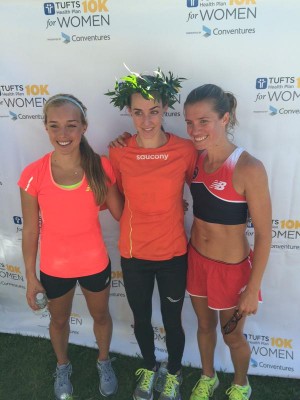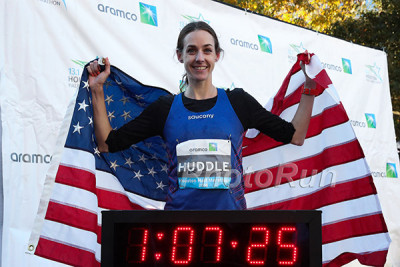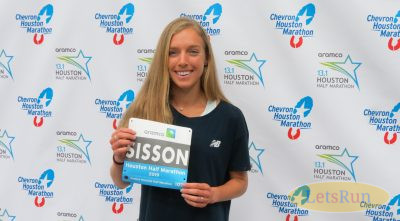Seeking Fast Times, Emily Sisson & Molly Huddle Arrive at London Marathon as Equals
By Jonathan Gault
April 26, 2019
LONDON — When they first met a decade ago at the Foot Locker Cross Country Championships, Emily Sisson looked up to Molly Huddle. Sisson was just a high schooler then, Huddle at the start of an ascendant professional career that would see her set American records in the 5,000, 10,000, and the half marathon and earn an astonishing 27 national titles — and counting.
Sisson transferred from the University of Wisconsin to Providence College in 2011 to work with Huddle’s coach, Ray Treacy, and as she emerged as the top woman on the team, winning a pair of NCAA 5,000 titles, she came to know Huddle better. But even when Sisson turned professional in 2015 and began working out with Huddle regularly under Treacy, it took her a while to consider herself Huddle’s equal. She managed all right in long runs and tempo runs, but few women in the history of American distance running have been able to hit it as hard as Huddle on the track. In those first few years, Sisson would struggle to hold on to Huddle in workouts; the next day, she’d wake up sore from the beating Huddle had laid on her legs.
Huddle didn’t feel entirely comfortable, either. She got along well with Sisson, but the seven-year age gap meant that she had been cast in the role of mentor, essentially by default. She viewed it as a learning experience, but a good one.
“I’m not used to being in charge, ever,” Huddle says.
But gradually, things began to shift. As Sisson grew stronger, she hung on better in workouts until reaching the point where she confident enough to lead a few reps, then a few more. By 2017, they were running step for step with each other, Huddle winning her third straight US 10,000-meter title as Sisson placed third to make her first World Championship team on the track.
“I think it took her a few years to be like, I’m a peer with you,” Huddle says.
No one would argue that the two are peers now. In January, Sisson ran 67:30 at the Houston Half Marathon, missing Huddle’s American record by just five seconds. Then on March 29, Sisson broke Huddle over the final laps to win the 10,000 at the Stanford Invitational 10,000, running 30:49.57 to Huddle’s 30:58.46 — her first victory over Huddle in 21 attempts, according to the track database Tilastopaja.
But when it came time for Sisson to make her marathon debut — one of the most anticipated debuts by an American in recent years, given her success in Houston — she still couldn’t help but follow Huddle’s lead.
“I wanted to do a spring marathon,” Sisson says, “and I knew Molly wanted to do a fast one in the spring, so I was kind of like, ‘Well, what one do you want to do? Because I’d like to have you in that race.’”
***
That race is the London Marathon, which goes off here in the British capital on Sunday (4:25 a.m. ET start). Huddle chose it because, at 34, she knows this may be her last opportunity to register a truly fast personal best. After London, if all goes according to plan, her next two marathons will come at February’s Olympic Trials in Atlanta and the Olympics in Tokyo in August 2020, neither of which is conducive to running a fast time. Huddle’s first marathon opening would be the spring of 2021, at which point she’d be 36 years old. And while Treacy believes that Huddle has done a great job taking care of her body — “I think she still has a good 10k in her, a better half marathon than her record I think, definitely in her over the next year” — these sort of opportunities don’t come along often. The weather doesn’t always line up (the temperature, around 50 degrees and overcast at race time, looks great in London, though projected 14 mph winds could be an issue), and running a race like London again in future would require passing up bigger paydays from Boston and New York.
“When you get to be my age, you never know how many more years you have performing your best,” Huddle says. “We look at this as my chance to run fast for now, and the best chance.”
How fast? Huddle says she has a range of outcomes that she’d be happy with, depending on how the myriad variables of the marathon play out.
“I’d be happy with 2:21-2:23 range,” Huddle says. “There’s a lot dependent on wind and just how I feel and just how it goes.”
Huddle’s current personal best stands at 2:26:44, good for fourth place in New York last fall, but there are several reasons she expects to run faster than that. For one, Huddle, like the rest of the lead pack, went out conservatively in New York, hitting halfway in 75:50 and closing her second half in 70:54. For another, Huddle’s buildup hadn’t gone all that well. She felt worn down after seven weeks of grueling altitude training, and lost to Sara Hall at the US 10-mile road championships in October, ending a 14-race win streak in US road championships that dated back to 2012. Huddle even considered pulling the plug and bailing on New York altogether.
“My workouts were just bad but nothing was injured per se, just bad,” Huddle says.
But Huddle draws confidence from the fact that, even if it wasn’t as high-quality as she would have liked, she still logged a lot of work in that buildup. And both she and Treacy believe her London buildup has gone significantly better. She went into Stanford last month not sure if she’d be able to break 31:30, so was pleasantly surprised that she was able to run 30:58 off of marathon training, even if she wishes she would have been able to hold on to Sisson a bit longer in the race — a role reversal, as Huddle is usually the one grinding fields into submission.
Huddle says that she was still “ascending” at that point, whereas Sisson was starting from a higher point, having run that 67:30 in Houston. Huddle believes that with another month of training — and a jump up to 26.2 miles — that gap has narrowed, but she doesn’t know by exactly how much.
“She’s still maybe a little bit ahead but it will be good,” Huddle says. “I think we’ll be able to run together for almost the whole race and then at the end, we’ll see what happens…I know it’s her first marathon, but she’s in really good shape. She’s really ready for it. I’m pretty sure I’m right there, but we’ll see.”
***
Sisson’s London prep could not have gone better. Unlike Huddle, she did not run a fall marathon, so everything she has done since September has been geared toward this race. Not much of that has been with Huddle — though they will get together for some easy runs, the two only ran one workout together in this buildup, a five-mile tempo in London on Tuesday. Sisson, 27, says she was bummed at first when she realized she wasn’t going to be working out with Huddle, but, especially with this being her first buildup, Treacy didn’t want to give her anything she couldn’t handle.
“I was trying to do what was best for each individual rather than throwing them together and say, okay, let’s see if this works for the two of you guys,” Treacy says.
Sisson has bumped up her mileage, to around 115 per week, and the transition has been seamless.
“My body felt better doing that training than doing maybe 90 miles a week and getting on the track twice a week,” Sisson says.
Everything suggests that Sisson is a natural-born marathoner — a belief Treacy has espoused since her days as a collegian. But no one in her camp wants to call Sisson a world-class marathoner until she’s actually run one.
“The longer I’ve gone up in distance on the road, I’m generally better, and in my workouts, I’m better at long runs and tempos, so all signs would point that I’d be good at longer stuff,” Sisson says. “But with the marathon, there’s just so many variables, and I think that’s going to be the hardest part for me.”
Sisson says the variable she’s most nervous about is fueling. Taking gels on long runs was difficult for her, and it took her a while to discover the right mix for her sensitive stomach.
“I am not used to having that much sugar,” Sisson says. “I remember after my first long run, I had to run in the house and brush my teeth. It just felt so gross and my stomach was so upset.”
Sisson settled on a mix of 3/4 of a packet of gel and water; as long as she remembers to drink it slowly during the race, she thinks she’ll be okay.
The question of how fast Sisson can run on Sunday has been a hot one in American distance running circles ever since her 67:30 in Houston. Jordan Hasay, the last American to approach Sisson’s level of hype for a debut, ran 67:55 leading up to her first marathon in Boston in 2017 and wound up setting the US debut record of 2:23:00. If Sisson races to her potential, that record could well fall, especially considering London, site of the two fastest female marathon times ever as well as Deena Kastor‘s American record of 2:19:36, is a faster course than Boston.
“Low-2:20s is my goal just because I feel like that’s what it’s going to take to make the [2020 Olympic] team,” Sisson says. “So if I want to do the marathon at the Trials, that’s my goal, to make the team. So I think it will be like 2:22, 2:23, that fitness level will make it.”
The plan, weather permitting, is for Sisson and Huddle to go out together in 71:00 for the first half (as far as they know, they won’t have a dedicated pacemaker), a pace both women believe they can handle. From there, they’ll see how fast they can close.
“We’re both really happy that we have each other in the race because if we don’t have a group to run with, which I think often happens in this race, then we still have each other,” Sisson says. “We know that we’re in similar enough shape that we can run together for quite a bit of it. We hope that we can run together for a really long time.”
Huddle’s relationship to Sisson has changed over the years — from idol to mentor to training partner to friend — and even for the first half of Sunday’s race, they will be working together more than working to beat the other. But at some point, that will shift. One woman will make a move, or one will drop off, and in that moment, if only for a few minutes, that relationship will change once more. They’ll be rivals.
***
LRC pre-race interviews with Sisson & Huddle











